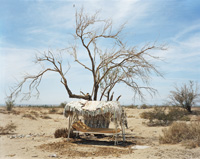Fake advertisements for futuristic products. Centerpieces made out of plastic water bottles. Frogs in a jar. These are just a few of the objects visitors can expect to see at the Tikkunim art exhibit currently on display at Howard House in downtown Seattle.
The exhibit, which is being presented in conjunction with the Seattle Jewish Film Festival, highlights 10 different artists, all of whom are Jewish and whose work focuses on the causes and possible solutions to the planet’s ecological concerns.
“There’s actually a bit of a movement of artists working in this paradigm,” said Tamar Benzikry-Stern, curator for Tikkunim. “And a number from the origin of that movement are Jewish.”
The name Tikkunim refers both to the notion of tikkun olam, or “repairing the world,” as well as Jewish study guides known as tikkunim that provide different versions of the same material for reading from and writing a Torah, just as each artist presents a different mode of commenting on the theme of environmental healing.
Tikkunim’s artists come from all over the country, including three from the Seattle area. Benzikry-Stern noted that although each claims Jewish roots, the artists represent a wide cross-section of religious observance.
“Not all are practicing Jews, and not all of the artists even identify as Jewish. But they are all informed by the notion of tikkun olam,” she said. “That’s something that runs through each of these piece.”
Though the emphasis of the show is on repairing the environment, different artists seem to approach the topic with varying degrees of optimism. Architect George Ostrow builds sukkot out of used materials, demonstrating a clever, and joyful way to make something old new again. Similarly, Ilene Sunshine creates sculptures out of parts of discarded Christmas trees. The work of Ruth Wallen has a darker side to it, using frogs, both real and in cartoon form, to illustrate the harmful impact humans have had on one specific corner of the natural world.
The exhibit coincides with this year’s Seattle Jewish Film Festival and was designed to complement the festival’s theme of “Go Green,” which will have an emphasis on films about environmentalism and ecology as well as employing sustainable festival practices.
“This exhibit was actually the cornerstone of the entire “˜Go Green’ idea,” said festival director Pamela Lavitt. “It was the first seed that was planted.”
Lavitt noted that both Benzikry-Stern and Bill Howard, owner of Howard House, are members of the Seattle Jewish Film Festival committee.
“All three of us wanted to get this message out of going green for the festival,” Lavitt said of the exhibit’s genesis.
Lavitt said she is excited to see that theme expressed beyond the confines of the movie theater.
“We’ve been trying to transform [the film festival] into more of a cultural event,” Lavitt said. “These are exhibits that teach us something new about our community and how we interact with the world. Hopefully this is content that people will ponder for longer than just the length of a film.”
This is the first time the festival has partnered with Howard House.
“I think this exhibit is very path-breaking,” Lavitt said. “A lot of these artists have known each other’s work but never shown together before.”
Benzikry-Stern said that she found artists for the exhibit largely through word of mouth.
“I’d just talk to one person and she’d tell me about what someone else was doing,” she said.
Benzikry-Stern was quick to add that she hopes the exhibit will appeal to a broad audience — not just the Jewish community, but anyone who is interested in damage humans have done to the environment and the ways we can began to repair it.
“I think that this show is specific to one community, but it has a really universal message, in the same vein that film festival tries to show, through a Jewish lens, universal issues,” she said.
Art for the Earth
